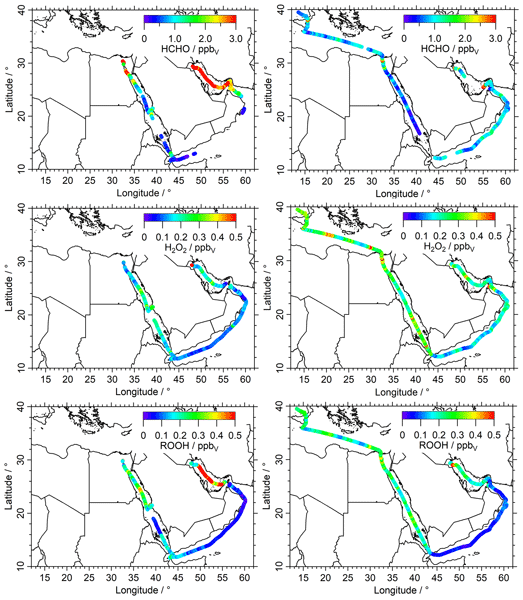New publication on the evaluation of EMAC

A new study of D. Dienhart et al. has been published in the open access journal “Atmospheric Chemistry and Physics”. In the publication “Formaldehyde and hydroperoxide distribution around the Arabian Peninsula – evaluation of EMAC model results with ship-based measurements” the authors evaluate EMAC results with ship-borne measurements around the Arabian Peninsula.
https://doi.org/10.5194/acp-23-119-2023
Abstract: Formaldehyde (HCHO), hydrogen peroxide (H2O2) and organic hydroperoxides (ROOH) play a key role in atmospheric oxidation processes. They act as sources and sinks for HOx radicals (OH + HO2), with OH as the primary oxidant that governs the atmospheric self-cleaning capacity. Measurements of these species allow for evaluation of chemistry-transport models which need to account for multifarious source distributions, transport, complex photochemical reaction pathways and deposition processes of these species. HCHO is an intermediate during the oxidation of volatile organic compounds (VOCs) and is an indicator of photochemical activity and combustion-related emissions. In this study, we use in situ observations of HCHO, H2O2 and ROOH in the marine boundary layer (MBL) to evaluate results of the general circulation model EMAC (ECHAM5/MESSy2 Atmospheric Chemistry; European Center HAMburg, Modular Earth Submodel System). The dataset was obtained during the Air Quality and Climate Change in the Arabian Basin (AQABA) ship campaign around the Arabian Peninsula in summer 2017. This region is characterized by high levels of photochemical air pollution, humidity and solar irradiation, especially in the areas around the Suez Canal and the Arabian Gulf. High levels of air pollution with up to 12 ppbv HCHO, 2.3 ppbv ROOH and relatively low levels of H2O2 (≤0.5 ppbv) were detected over the Arabian Gulf. We find that EMAC failed to predict absolute mixing ratios of HCHO and ROOH during high-pollution events over the Arabian Gulf, while it reproduced HCHO on average within a factor of 2. Dry deposition velocities were determined for HCHO and H2O2 at night with 0.77±0.29 cm s−1 for HCHO and 1.03±0.52 cm s−1 for H2O2 over the Arabian Sea, which were matched by EMAC. The photochemical budget of H2O2 revealed elevated HOx radical concentrations in EMAC, which resulted in an overestimation of H2O2 by more than a factor of 5 for the AQABA dataset. The underestimated air pollution over the Arabian Gulf was related to EMAC’s coarse spatial resolution and missing anthropogenic emissions in the model.
© Author(s) 2023. This work is distributed under the Creative Commons Attribution 4.0 License.
Dienhart, D., Brendel, B., Crowley, J. N., Eger, P. G., Harder, H., Martinez, M., Pozzer, A., Rohloff, R., Schuladen, J., Tauer, S., Walter, D., Lelieveld, J., and Fischer, H.: Formaldehyde and hydroperoxide distribution around the Arabian Peninsula – evaluation of EMAC model results with ship-based measurements, Atmos. Chem. Phys., 23, 119–142, https://doi.org/10.5194/acp-23-119-2023, 2023.
